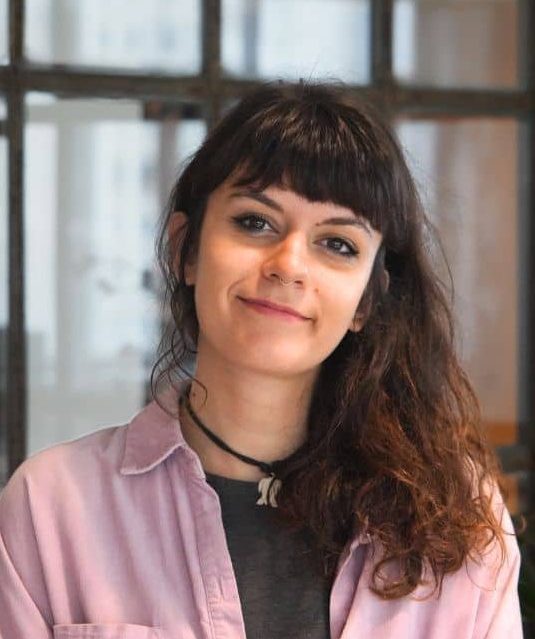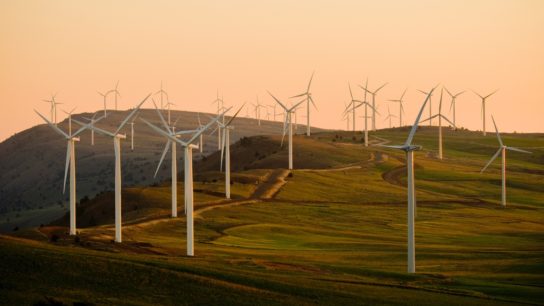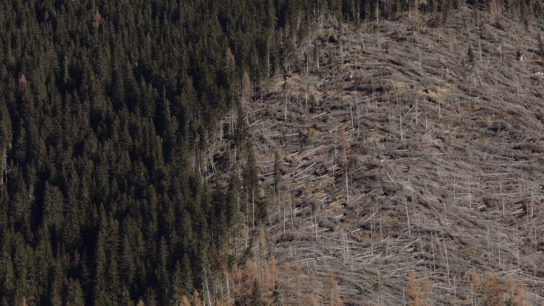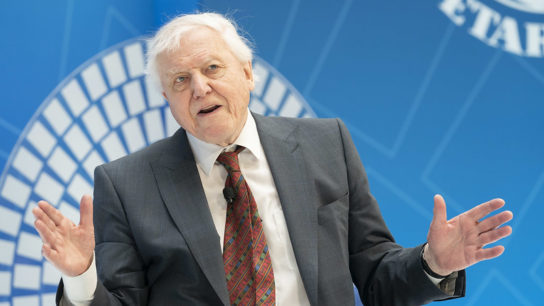The 29th United Nations climate change conference (COP29) kicked off on November 11 in Baku, Azerbaijan, with some 53,000 attending. Building on previous negotiations, the UN climate summit is expected to seal and ensure efforts toward climate justice, focusing primarily on providing vulnerable nations with adequate funding to adapt to and recover from the impacts of climate change. Here is a recap of everything that happened during COP29 week 1.
—
Nationally Determined Contributions (NDCs)
- United Kingdom: Speaking on the second day of the summit, UK Prime Minister Keir Starmer announced that his country will cut greenhouse gas emissions by 81% by 2035 relative to 1990 levels. Greenpeace said the move was as a sign that the UK is “willing to be a global leader on climate.”
- Indonesia: Speaking at an event eld on the sidelines of COP29, Indonesia’s Environment director at the National Development Planning Ministry, Priyanto Rohmatullah, said his country plans to start taking measures to pursue greenhouse gas emission reduction targets at the provincial level starting in 2025. The country aims to reach net-zero by 2060 or sooner.
- Brazil, United Arab Nations (UAE): Brazil announced its new commitment to reduce emissions by 59% to 67% by 2035, as compared to 2005. Compared to the previously established 2030 target, the ambition for absolute emissions reduction has increased by 13% to 29%. Meanwhile, the UAE committed to a target of reducing emissions by 47% by 2035 compared to the 2019 baseline. However, neither NDCs are aligned with the 1.5C goal. They also do not present a pathway to reduce their oil and gas production – critical as both countries have expansion plans.
Carbon Trading/Article 6
Article 6.4
The COP29 Presidency fast-tracked the adoption of a centralized carbon trading mechanism on day one of the summit. The move clears the way for the long-awaited global carbon market set out in Article 6.4 of the Paris Agreement, which will be open to countries and companies to trade through under UN supervision, to become operational. The system effectively allows countries to buy credits for removing/avoiding planet-warming pollution around the world, e.g. by planting trees or protecting rainforests. But while this is viewed as tangible progress Article 6, which has been stuck on issues that have plagued it since the Paris Agreement was signed in 2015, there is still no clarity on the methodology to implement it.
The agreement was rushed and adopted without discussion and negotiations, prompting widespread criticism. Isa Mulder, a policy expert at the non-profit group Carbon Market Watch, said that adopting the rules on the first day of the summit without discussion “undermined trust” in the UN climate conference process. “Kicking off Cop29 with a backdoor deal … sets a poor precedent for transparency and proper governance,” she said.
REDD+
The Integrity Council approved three methodologies for issuing high-integrity carbon credits for reducing emissions from deforestation and forest degradation in developing countries (REDD+). Leading nature NGOs have welcomed the announcement as Article 6 negotiations rumble on. A high-integrity carbon market has the potential to unlock funding that would not otherwise be available for natural climate solutions.
The latest Stern-Songwe report warns that by 2035, developing countries, excluding China, would need $1.3 trillion/year in climate finance. This will require an increase in private sector investment – which high-integrity carbon credits can help generate.
Methane
Tracking
The new United Nations Environment Programme’s (UNEP) “An Eye on Methane” report highlights how little governments do to check methane emissions despite making pledges. The analysis finds that only over 1% of governments and companies have responded to methane alter leaks from around the world. Read the report.
Companies pledges
Oil and gas companies are exacerbating the climate crisis by failing to set strict targets to stop methane leaking into the atmosphere, according to a report from financial think tank Carbon Tracker. While most large producers have announced plans to cut emissions from their operated Upstream assets to “near zero” by 2030, the report reveals no companies have set targets that cover all methane emissions related to their business activities.
The report assesses and ranks pledges to reduce greenhouse gas emissions made by 30 of the largest oil and gas producers. It reveals that the industry’s commitment to reducing overall emissions has stalled for the second year running and also warns that companies’ strategies for meeting their emissions targets are of “questionable credibility.” Read the report.
Meat and Dairy
A new analysis by the Changing Markets Foundation exposes methane greenwashing tactics by Big Meat and Dairy, revealing woefully inadequate national strategies for methane reduction in countries where largest meat and dairy corporations are headquartered.
Changing Markets analysed the policy landscape in the 11 countries where the largest meat and dairy companies are headquartered, and found that nearly all national strategies lack mandatory requirements for agricultural emissions reductions, cuts in livestock production, or the inclusion of agriculture in any form of greenhouse gas pricing scheme. Instead, the landscape is dominated by supply-side, technically-oriented policy solutions and support – particularly for biogas from manure – that will fail to achieve the significant emissions reduction required to avert climate breakdown. Read the report.
Climate Finance
New Collective Quantified Goal (NCQG)
The first, 35-page NCQG draft negotiating text released on Wednesday links climate finance with biodiversity, land, and sustainable development and recognizes Indigenous Peoples’ climate leadership. Key issues remain to be discussed, including the total amount, review frequency of climate reporting, and the timeline.
In the latest NCQG text published on Saturday, participants focused on technical aspects like access, transparency, and factors that enable or hinder progress. However, major political challenges persist, largely because many components are intertwined with the overall structure of the goal. There is ongoing debate about whether it should be a single-layer provision or a multi-layer goal with broader financial sources. Observers note this reflects the typical divide between developed and developing countries. Numerous options are still bracketed in the text.
Read this explainer by Carbon Brief to learn more about the NCQG.
Adaptation
Finance flows to enhance adaptation efforts are not remotely close to what is needed, particularly in climate-vulnerable developing countries, to keep up with the rapidly intensifying impacts of climate change, according to the latest edition of the UN Environment Programme’s (UNEP) Adaptation Gap Report. An increase of US$6 billion in funding from the developed world between 2021 and 2022, the largest year-on-year increase since the Paris Agreement, represents an “encouraging sign,” UNEP said last week. Yet the world is far off track on what is really needed, estimated at around $359 billion a year.
Agriculture
A new report found that total climate finance gap for agriculture and land-use across Africa totals US$55.47 billion by 2030 – broken down into $15.8 billion for mitigation objectives and $32.68 billion for adaptation objectives. Concerningly, the percentage of debt instruments as a share of total annual allocated funding appears to be increasing – in the last three years, debt related instruments have on average accounted for 43.7% of the annual total Agriculture, Forestry, and Other Land Use (AFOLU) allocations (peaking at 52% of the annual total in 2020). This increase in the use of debt instruments is of particular concern given the debt vulnerability of countries in the region. Read the report.
Energy
Multiple countries including the UK, Uruguay, Belgium and Sweden committed to increasing the amount of global energy storage sixfold compared to 2022 levels, or 1,500 Gigawatts of capacity by 2030. The commitment comes a year after 133 countries committed at COP28 to tripling renewable energy capacity and doubling rates of energy efficiency by 2030.
Renewable Energy
(From E3G) The COP29 Presidency marked energy day with the launch of three energy pledges:
- Global Energy Storage and Grids Pledge, which targets a sixfold increase in global energy storage to 1500GW and a significant grid expansion by 2030 – critical for tripling renewables and decarbonising the power sector.
- Green Energy Zones and Corridors Pledge, which is a welcome attempt at establishing regional and international cooperation on renewable energy deployment and regional power transition infrastructure, but any attempts to use this pledge to expand gas infrastructure need to be curbed.
- Hydrogen Declaration, which aims to catalyse a global clean hydrogen market. Decarbonizing production of hydrogen is important, but the focus needs to be on green hydrogen, which for cost reduction is dependent on the renewable tripling target. While Green H2 is important for industrial decarbonisation, it is not a silver bullet, and should not delay action on fossil fuels.
The European Bank for Reconstruction and Development, the Asian Development Bank and the Asian Infrastructure Investment Bank agreed to finance the construction of two Azerbaijani solar power plants that are estimated to cost $670 million in total.
Sea Level Rise
A new World Bank report said adapting to a sea level rise of up to 0.5 metres (1.64 feet) will cost the three most vulnerable Pacific atoll nations nearly $10 billion – equivalent to about 20 years of gross domestic product.

Deforestation
14 countries part of the Forest & Climate Leaders’ Partnership (FCLP) issue a political statement underscoring their commitment to scaling up finance for forests. They called for greater private sector investment and highlighted that momentum is now building to bring finance for forest carbon to scale, to greatly increase impact.
The UK and Guyana formerly took on the role of co-chairs of the FCLP from the US and Ghana.
Through the FCLP, around $55 million – representing 10.6% of total pledge funds – reached Indigenous Peoples (IPs) and local communities (LCs) in 2023, up from 2% in 2022.
Food
Food waste
A new report by global environmental action non-profit WRAP shows of the 195 countries attending COP29, only 12 have committed to reducing food waste and just 17 to tackling food loss. In total, 24 countries (12%) commit to reducing food loss and/or waste while 88% attending the global climate conference have made no commitments to address either so far in their NDCs. Read the report.
Smallholder farmers
Based on an investment of $300 per farmer per year, One Acre Fund calculates that approximately $153 billion would be required annually to support the estimated 511 million smallholders worldwide farming less than two hectares of land to build climate resilience. Currently just $2 billion of global climate finance from both public and private sources reaches smallholder farmers, revealing a financing gap of $151 billion. The social enterprise estimates that filling this gap would yield $403 billion in value for smallholders globally, taking into account higher yields, increased revenue, improvements in soil quality, healthier families, and the long-term economic and ecological benefits of agroforestry. Read more.
You might also like: Opinion: To Save Our Soil, Invest in Smallholder Farmers
Others
- Backtracking: France and Argentina have withdrawn their top negotiators from the COP29 summit in Azerbaijan.
- Host: In his keynote address at the COP29 climate summit, Azeri President President Ilham Aliyev hit out at the West in defence of oil and gas. Aliyev earlier this year called fossil fuels “a gift from God.”
- Controversy: Elnur Soltanov, the COP29 chief executive, appeared to use his role at the UN climate summit to facilitate fossil fuel deals, as shown in leaked meeting recordings. The undercover investigation by campaign group Global Witness exposed Soltanov, also Azerbaijan’s deputy energy minister, agreeing to sponsorships in exchange for aiding oil and gas deals, a move that clashes with the global push towards climate adaptation and mitigation efforts.
- Lobbyists: At least 1,773 fossil fuel lobbyists have been granted access to COP29, according to an analysis by the Kick Big Polluters Out coalition. At least 2,456 representatives from the world’s largest polluters were granted access to the talks last year, which saw 85,000 people in attendance. This year, some 52,000 people are attending the summit. The Guardian also revealed that at least 480 lobbyists working on carbon capture and storage (CCS) have been granted access to the talks this year, five times more than were present at COP28.
- Human rights violations: Human rights groups accuse the Azerbaijani government to use COP29 to crack down on environmental activists and other political opponents.
- COP reform: A group of influential climate policy experts, including former UN secretary-general Ban Ki-moon, the former president of Ireland Mary Robinson, the former UN climate chief Christiana Figueres and the prominent Earth scientist Johan Rockström said in a letter that COP summits are “no longer fit for purpose.” They demanded that the current complex process of annual COP meetings be streamlined, with summits held more frequently and allowing developing countries greater influence in the process. “We need strict eligibility criteria to exclude countries who do not support the phase-out/transition away from fossil energy. Host countries must demonstrate their high level of ambition to uphold the goals of the Paris agreement,” the group wrote.
Remarks
- UN Secretary-General António Guterres, Exxon’s CEO Darren Woods, the Kremlin envoy and former US climate envoy John Kerry urged President-Elect Donald Trump not to leave the Paris Agreement again.
- Brazil’s President Lula, whose country will host COP next year, is urging Trump to not walk away from the climate fight.
- US climate envoy John Podesta said the fight “for a cleaner, safer” planet will not stop under Trump even if some progress is reversed. “Although under Donald Trump’s leadership the US federal government placed climate-related actions on the back burner, efforts to prevent climate change remain a commitment in the US and will confidently continue,” Podesta said on Monday.
- Simon Stiell, the UN’s climate chief, said G20 leaders must agree to provide the finance that the world’s poorest need to tackle the climate crisis or face “economic carnage.”
COP29 Agenda and Thematic Days (click to view)
- Day 1 (11 November): Opening day
- Day 2 (12 November): World Climate Action Summit
- Day 3 (13 November): World Climate Action Summit
- Day 4 (14 November): Finance, Investment, Trade
- Day 5 (15 November) – Energy, Piece, Relief and Recovery
- Day 6 (16 November) – Science, Technology, Innovation and Digitalization
- Day 7 (17 November) – REST DAY
- Day 8 (18 November) – Human Development, Children and Youth, Health and Education
- Day 9 (19 November) – Food, Agriculture and Water
- Day 10 (20 November) – Urbanization, Transport, Tourism
- Day 11 (21 November) – Nature and Biodiversity, Indigenous People, Gender Equality, Ocean and Coastal Zones
- Day 12 (22 November) – Closing Plenary















—
Follow our COP29 coverage and updates here.
This story is funded by readers like you
Our non-profit newsroom provides climate coverage free of charge and advertising. Your one-off or monthly donations play a crucial role in supporting our operations, expanding our reach, and maintaining our editorial independence.
About EO | Mission Statement | Impact & Reach | Write for us














